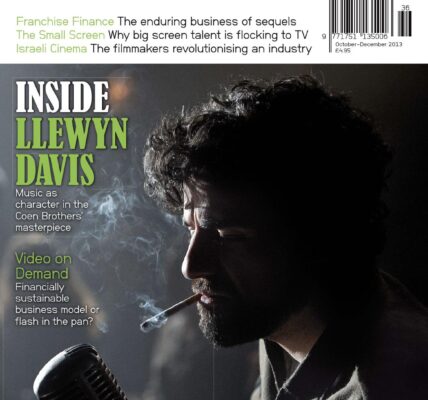Digital Colourist Rob Pizzey – Making The Grade
Having worked on films from The Scouting Book for Boys and Tyrannosaur to The Iron Lady and The Woman in Black, Rob Pizzey knows all too well just how valuable a digital colourist can be to a film’s look, feel—and budget.
Master DI colourist Rob Pizzey followed a classic route in post-production, joining Deluxe 142 (then Ascent) as a runner in 1992, with an aim to becoming a telecine operator. Three years later he was taken on as a nighttime TK assistant, but three more would pass before Pizzey could move onto the day shift, in the meantime gaining experience working on drama and documentaries. By 1999 he had moved into commercials and pop promos then, in 2004, came the chance to grade the Jerry Bruckheimer film King Arthur—and he’s never looked back. The Deluxe 142 digital intermediate (DI) facility has now been fully integrated into the London-, NYC- and LA-based Company 3 (CO3), where Pizzey works exclusively on the DaVinci Resolve system. When movieScope caught up with him, he was taking a break from DI work on a stereoscopic 3D stop-frame animation project for director Tim Burton.
Is this the first stop-frame project you have worked on?
It’s the first I’ve done the DI on, yes. It’s also in black-and-white, which is different for a colourist! It’s got quite a different look and mood. It’s pretty amazing. This is also my first 3D project, and it takes a lot longer. You grade everything in 2D first, then convert to 3D, then do the tweaks. It’s a lot more difficult grading in the 3D environment—by which I mean it takes a lot out of you. Having the images jump out at you is quite full-on. But all the pictures [we’re doing] look great in 3D.
You recently worked on The Woman in Black, which had a very strong look. Can you give us some more detail about that?
Obviously it’s a gothic horror story. [Cinematographer] Tim Maurice-Jones did a beautiful job of lighting it, but we really went to town in the DI, darkening off areas, pulling out certain parts of the picture to make it more of a scary experience in the cinema. It was shot on 35mm. Certain projects suit digital formats, but this one looked great on film.
There were a few scenes where they expected they’d have to do big visual effects fixes, and we managed to do them all in the grade. The clients were quite surprised. With the equipment we’ve got we can draw quite complex shapes, track them and basically relight scenes. I don’t like to use that word, in deference to cinematographers, but it’s good sometimes to use the kit to its full potential. Darkening the shot, adding shadows to a scene; remoulding a scene really.
What’s interesting about that film is that [the filmmakers] had to get a 12A certification in the cinema, so I had to regrade certain sections to get it down from a 15 certification to a 12A! It’s one of the weirdest sessions I’ve ever had—to change the certification of a film in the grade. This just entailed literally darkening off parts of the picture, for example where there’s bits of blood. There’s a scene with a dead body of a little boy where the face has gone rotten, and we had to darken his face and basically tone down some of the more gory effects. I do genuinely believe that by doing that it made it more scary, more sinister, but the censor said it was fine.
Where else do you think you’ve made an impact like that?
The grading session for Quantum of Solace saved the production company significant time and money. There was a week to set the looks for the various visual effects scenes in the film. Because of weather, there was no way the shots could be matched in camera and it was assumed that additional VFX time would be required for sky replacement. However, we managed to balance at least 80 per cent of the shots using the Resolve, saving considerable VFX budget.
You say you especially like working on projects that you get involved in from the start…
On The Iron Lady I worked very closely with the cinematographer Elliot Davies to create the different looks for Meryl Streep playing Margaret Thatcher as a younger woman and elderly lady. Elliot Davies shot different setups for various actors and actresses. Then Meryl came in and I graded some shots with Elliot; normal to begin with, to see how the make-up looked. We then picked some key shots of Meryl and graded them the way we thought we could see the film going, such as the more sombre mood later when [Thatcher] is older. They loved it and we used that as a template through the rushes stage, through the dailies and used it on the final DI.
If that film had just been graded normally, with full saturation throughout the dailies, and then they came into the DI and we graded it the way it ended up, the producers would have been saying, ‘Bloody hell, what’s going on?’ The way we did that gets everyone on the same page. That’s the good thing about getting involved in a project early on; at the dailies stage, you can get the look going.
You also got involved early on with your most recent job, a film of Henry V for the BBC. What was the experience like on that?
That’s going out on TV in a big Shakespeare season during the Olympics; Michael McDonagh, who usually does features, shot various tests for me to grade with him. We ended up creating about 15 looks for him to use on the shoot and for the dallies. That’s the most I’ve ever done. But it really worked. We had to do that in four-and-a-half days. It’s a two-hour, twenty-minute piece. I know it’s for TV, but literally every shot of that film involved things like shapes tracking around people’s eyes. It was full-on. Even the DP could not believe how quickly we got through it.
I have to add that the team around me are vital. Without them all, my life would be hellish. Each play a vital part in the DI process and CO3′s continued success.
The Woman in Black is out on DVD and Blu-ray now.
Taken from movieScope magazine, Issue 28 (May/June 2012)
SUBSCRIBE HERE to get 6 issues per year delivered to your door for just £4.99 per issue (UK postage included)












